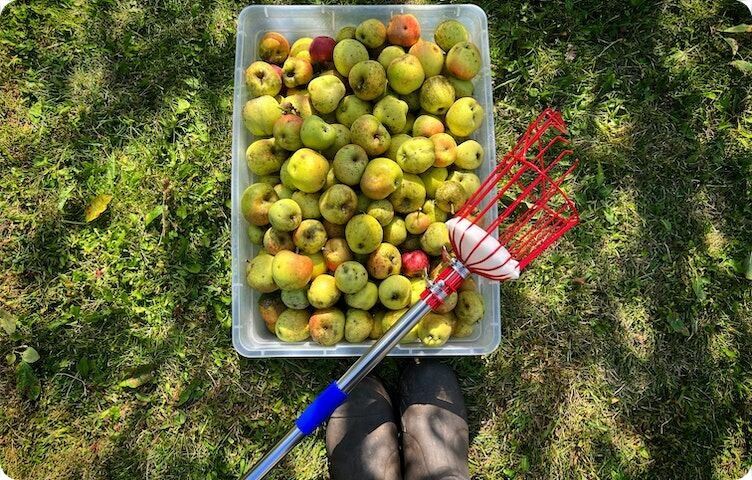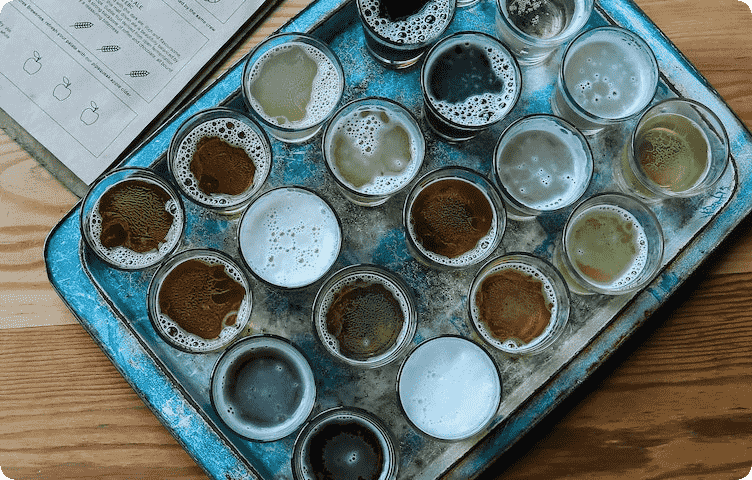At a summer picnic, a romantic dinner and a friendly party with friends , refreshing sweet and sour cider will be appropriate everywhere. There are 300 varieties of this product known - apple and orange, sparkling and still, strong and non-alcoholic. To better understand the features of this delicious fruit drink, let’s take a short excursion into its history.
What is cider?
The juice of ripe fruits and berries is an excellent raw material for the production of alcohol. During fermentation, fruit sugar is converted into ethyl alcohol and carbon dioxide. Adding yeast speeds up this process. Next, the liquid is filtered, carbonated, and sometimes sweeteners and spices are added. The result is an effervescent low-alcohol drink with a soft, rich taste.
The traditional raw material for making cider is apples, which are high in acids and tannins, but there are also pear varieties. In Southern Europe, “cidra” is popular, which is made from oranges. To enrich the taste and aroma, other berries and fruits are sometimes added to apple juice.
Among them:
- quince;
- mango;
- cranberry;
- cherry;
- grape;
- strawberry;
- blackberry.
To change the taste characteristics of the product, manufacturers increase or shorten the fermentation period and use different types of yeast. These technological techniques allow you to create different varieties.
How is cider different from wine?

The similarity between the two products is that both are prepared from fruits through fermentation. Even the raw materials can cause confusion, as there are apple wines and ciders with added grape juice.
Drinks are distinguished according to four criteria:
fermentation period – for wine products it is 1-2 months. Fermentation of apple juice lasts no more than 3 weeks;
alcohol content – according to world standards, it should be 9-12% for unfortified wine. The strength of the apple drink is 3-8%;
number of types - there are 3 main types of wines (red, white, sparkling) and only two types of cider (non-alcoholic and strong);
volume of residual sugar – a shorter fermentation process retains more fruit sugar in the apple must (6-15%). In different types of wine, no more than 2% sugar remains. For this reason, apple drink has a sweeter taste.
Sometimes hard ciders are mistakenly called wine. The main difference between these products is the duration of fermentation. If apples are fermented for a month or longer, the alcohol content rises to 12-14%, and the color of the liquid becomes rich golden or light red. According to technological standards, such a product belongs to wine.
History of the origin of cider

Low-alcohol drink made from apples has been known to man for 5,000 years. It was prepared in the countries of the Middle East, Ancient Greece and Rome. The first Europeans to master cider making were the inhabitants of the British Isles. They used only one type of raw material - small sour fruits called “crab” apples. The Romans, who conquered Britain in the 1st century AD, introduced the local population to sweet varieties of fruit originating from Asia.
By the 15th century, cider production had expanded so much that it became an everyday drink for Europeans. This was facilitated by the development of horticulture, which resulted in the appearance of 65 new varieties of apples. By experimenting with different types of fruit, English and French farmers created various versions of the product. It was often drunk simply to quench thirst, to avoid contaminated water that caused intestinal disorders.
In the 18th century, apple drink reached America. It soon gained such popularity in the New World that it began to be called “American champagne.” The product first appeared in Russia in 1890. Members of the family of Emperor Alexander III were the first to taste it. Within a few years, bottles of the fizzy drink were sold in ordinary shops. The scale of cider making increased significantly during the Soviet era.
The global cider market is now estimated at $5 billion. The product is widely distributed in North America, Europe and Russia.
Types of cider
There are two main types of drink based on alcohol content - regular and strong . The first option is made from unfiltered apple juice with remaining pulp and does not contain alcohol.
A typical example is the Heineken “Mr. Fox” product.
To obtain an alcoholic version, apple must is fermented with yeast. As a result, the product acquires a strength of 2.5 to 8%.
Hard cider is divided into four categories:
dry – contains less than 0.5-2% residual sugar. It has a fresh, sour taste and the highest strength;
semi-dry – retains 2-4% sugar. It has a pronounced taste of ripe apples and a sweet and sour aroma;
semi-sweet – leads in terms of volume of residual sugar (5-15%). The taste combines soft sweetness and sourness;
farmer's - fermented with wild yeast, due to which it acquires an earthy flavor and a strength of 7-8%.
There is also fruit cider, which is prepared with the addition of other fruits and berries. Among them, a special category stands out, the raw material for which is pear juice - perry.
There are subtypes of the drink prepared with various additives. Thus, hopped varieties, supplemented with hops, resemble fruit beer in aroma. Herbal versions are flavored with fragrant plants, tea, and flower petals. There is also a product with spices - ginger, cinnamon, cloves. Spices are added during fermentation or immediately after it.
What are the benefits of cider?

Fermenting apple juice produces probiotics that are essential for a healthy digestive tract. They improve intestinal microflora, stimulate digestion, and increase appetite. It has been observed that drinking cider relieves stomach pain.
Apples are rich in polyphenols, which also support proper intestinal function, normalize blood pressure and cholesterol levels. Antioxidants contained in apple peels slow down cell aging and prevent the development of cancer and heart disease. People on a gluten-free diet choose cider as a healthy alternative to beer.
Fermented juice retains many bioactive substances from fruits and berries - potassium, calcium, iron . The product enriches the body with vitamin C, which the body needs for normal immunity and protection against stress. It is especially useful to use it in the off-season, when the risk of respiratory infections increases.
How does modern cider differ from traditional cider?
If a low-alcohol drink is produced using malolactic fermentation, it is called traditional. With this fermentation method, malic acid is converted into softer lactic acid, which reduces acidity and improves the taste of the finished product.
Traditional cider making is common in England and Northern France. The raw materials for production are bittersweet and tart varieties of apples. They are fermented and aged in wooden barrels, resulting in a richer taste. French products contain more residual sugar and are usually classified as medium sweet.
Modern ciders made from table apples contain less tannin. In addition to fresh juice, concentrate is used in production. The taste of modern varieties combines soft sweetness and refreshing sourness.
What do you drink cider with?
The refreshing taste of the low-alcohol drink is combined with various types of cheese, meat and sweets. It is appropriate to serve it without any appetizer or with fruit and cheese slices. Dry and semi-dry varieties are in harmony with goat cheese, strong ones - with dor blue or cheese fondue.
Hard cider can be served instead of wine with a variety of meat dishes, including:
- fried pork;
- grilled steaks;
- spicy sausages;
- roast turkey;
- chicken nuggets.
Apple freshness pleasantly complements pastas with thick sauces such as carbonara or alfredo. When watching a movie at home with friends, cider is a great substitute for beer, added to popcorn and potato chips.
But the taste of the product is best demonstrated with desserts - charlotte, sweet pancakes, gingerbread.
The drink is served to the table chilled to a temperature of + 8-10 ° C. The dishes should be made of transparent glass so that guests can see the color and movement of the bubbles. There are no strict requirements for the shape of the vessels - you can use tulip wine glasses, white wine glasses or tall beer glasses .
















































/https%3A%2F%2Fcomplexbar.com%2Fimages%2Fblog%2F244%2Fhistory-sidr.jpg)
/https%3A%2F%2Fcomplexbar.com%2Fimages%2Fblog%2F246%2Fsirop_scale_2400.jpeg)
/https%3A%2F%2Fcomplexbar.com%2Fimages%2Fblog%2F246%2Fkofe-vostochniy.jpg)
/https%3A%2F%2Fcomplexbar.com%2Fimages%2Fblog%2F245%2Fpexels-jason-villanueva-851555.jpg)
/https%3A%2F%2Fcomplexbar.com%2Fimages%2Fblog%2F246%2F2024-04-09_17.22.54.jpg)
/https%3A%2F%2Fcomplexbar.com%2Fimages%2Fblog%2F246%2F2024-04-09_17.22.47.jpg)
/https%3A%2F%2Fcomplexbar.com%2Fimages%2Fblog%2F246%2FCODE_anons_foamydrops_752%D1%85480_eng.jpg)
/https%3A%2F%2Fcomplexbar.com%2Fimages%2Fblog%2F246%2FAlina_752%D1%85480_eng.jpg)
/https%3A%2F%2Fcomplexbar.com%2Fimages%2Fblog%2F246%2F2024-04-09_17.23.22.jpg)
/https%3A%2F%2Fcomplexbar.com%2Fimages%2Fblog%2F246%2F2024-04-09_17.23.28.jpg)
/https%3A%2F%2Fcomplexbar.com%2Fimages%2Fblog%2F246%2F2024-04-09_17.23.35.jpg)
/https%3A%2F%2Fcomplexbar.com%2Fimages%2Fblog%2F246%2Fdrinksome_752%D1%85480_eng.jpg)
/https%3A%2F%2Fcomplexbar.com%2Fimages%2Fblog%2F246%2Fnude_752%D1%85480_eng.jpg)
/https%3A%2F%2Fcomplexbar.com%2Fimages%2Fblog%2F246%2F752%D1%85480_eng__1_.jpg)
/https%3A%2F%2Fcomplexbar.com%2Fimages%2Fblog%2F246%2F752%D1%85480_eng.jpg)
/https%3A%2F%2Fcomplexbar.com%2Fimages%2Fblog%2F246%2FStudioRaw_752%D1%85480_eng.jpg)
/https%3A%2F%2Fcomplexbar.com%2Fimages%2Fblog%2F246%2FDoppio_tea_752%D1%85480_eng.jpg)
/https%3A%2F%2Fcomplexbar.com%2Fimages%2Fblog%2F246%2FTognana_Stars_Stripes_752%D1%85480_eng.jpg)
/https%3A%2F%2Fcomplexbar.com%2Fimages%2Fblog%2F246%2FRona_752%D1%85480_eng.jpg)
/https%3A%2F%2Fcomplexbar.com%2Fimages%2Fblog%2F246%2FDoppio_vending_752%D1%85480_eng.jpg)
/https%3A%2F%2Fcomplexbar.com%2Fimages%2Fblog%2F246%2FEssence_sukhie_smesi_752%D1%85480_eng.jpg)
/https%3A%2F%2Fcomplexbar.com%2Fimages%2Fblog%2F246%2FODK_sukhie_smesi752%D1%85480_eng.jpg)
/https%3A%2F%2Fcomplexbar.com%2Fimages%2Fblog%2F246%2Funiforma-barmena.jpg)
/https%3A%2F%2Fcomplexbar.com%2Fimages%2Fblog%2F246%2Fkak-nanyat-barmena.jpg)
/https%3A%2F%2Fcomplexbar.com%2Fimages%2Fblog%2F246%2Fsirop_scale_2400.jpeg)
/https%3A%2F%2Fcomplexbar.com%2Fimages%2Fblog%2F246%2FPeugeot_Anons_Paris_U%27Select_Line_Daman_752%D1%85480_eng.jpg)
/https%3A%2F%2Fcomplexbar.com%2Fimages%2Fblog%2F246%2Fkofe-vostochniy.jpg)
/https%3A%2F%2Fcomplexbar.com%2Fimages%2Fblog%2F246%2FMadler.jpg)
/https%3A%2F%2Fcomplexbar.com%2Fimages%2Fblog%2F246%2Fprofbartender_glavn.jpeg)